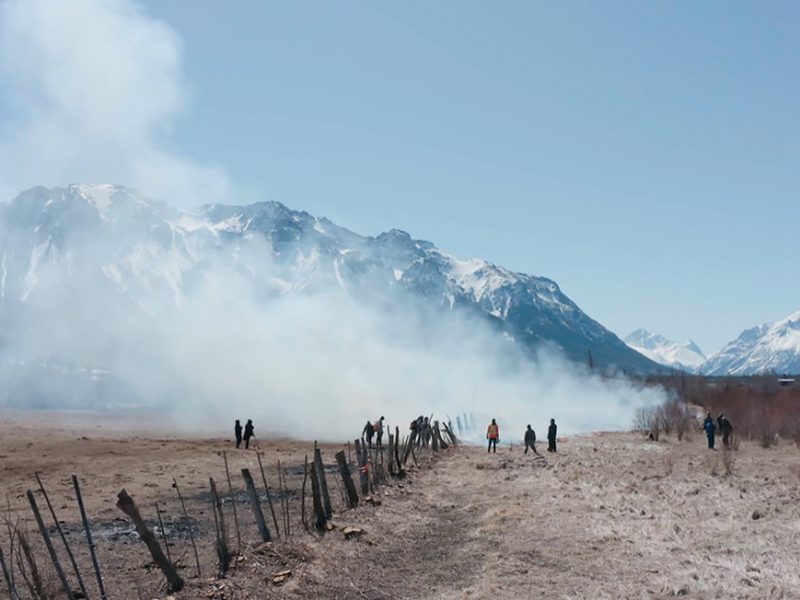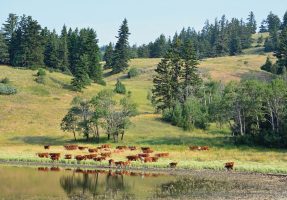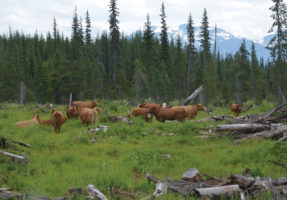VICTORIA – On June 29, the province’s independent watchdog for forest and range practices released a report citing urgent action as 45% of public land is at high or extreme threat of wildfire.
“Fire prevention and suppression policies over the past century have led to a buildup of fuel in our forests and have contributed to the loss of natural firebreaks in some areas,” Forest Practices Board chair Keith Atkinson said in releasing the report. “These shifts, combined with forestry policies and climate-change effects greatly increase the risk of catastrophic wildfire. We’re already seeing the consequences this year with its unusually early start and record-setting wildfires.”
Montney rancher and Peace River Regional Cattlemen’s Association president Dave Harris has experienced the result of fuel build-uo more than once.
“When [the Siphon Creek] fire went through [in 2016], it consumed and burned a lot of standing timber. Logging companies came in and logged what they thought was salvageable and left the rest,” Harris says. “They also leave a considerable amount of coarse woody debris laying on the forest floor, which is their new practice.”
In July 2021, a windstorm knocked down whatever standing dead wood remained from the fire five years earlier. The wildfire and wind combination left a 30-mile-long swath of burnable material, Harris says.
As a result, he discussed his concerns and the need to clean up the debris with the Peace River Regional District, the BC Ministry of Forests, and Canfor, the company that owns the logging rights in most of the affected area.
“Canfor was the most honest about it because they said there wasn’t enough profit for them to do that,” Harris says, noting that the province was more reticent given its obligations to First Nations.
Fast forward to this spring when the wildfire season arrived in May due in part to warm temperatures and a severe drought that began in the fall.
The Stoddard Creek fire encroached on Harris’s property but, thankfully, the only significant loss was fencing. Harris, along with other area ranchers, is certain this year’s historic wildfire season in the Peace could have been prevented with better landscape maintenance.
“There was a tremendous fuel load that was left here. And it was almost criminal negligence to do this because it wasn’t only my ranch, but there’s other ranches and farms east of me that could have been impacted if it wasn’t stopped on our property,” Harris says. “And this was all part and parcel of this material that was left lying and they had two years to do something about it. It would have cost the government money or somebody money, but to leave a potential hazard like that is actually appalling.”
Harris had spent quite a bit of time and money cleaning up the debris on his property following the storm but with the fuel left on Crown land, the Stoddard Creek fire was all-consuming and burning hot by the time it reached Harris’s ranch.
The FPB report says that bold and immediate action are required by the province to align policies and programs across all levels of government to achieve landscape resilience. Landscape fire management addresses forest fuel build-up, improves landscape resilience and reduces wildfire risk, including creating fuel breaks, increasing the diversity of tree species and ages, decreasing forest density and using cultural and prescribed burning.
While fire is at the centre of the board’s concerns, proponents believe it can also be part of the solution.
“You can look at archaeological evidence, and you don’t see the scale of massive wildfires that you do on the landscape as you do today,” says UBC assistant forestry professor and Gathering Voices Society executive director William Nikolakis. “We contend that’s because we built these unhealthy landscapes. It’s not just climate change.”
Gathering Voices focuses on advancing environmental stewardship programs for First Nations across Canada. Nikolakis works with First Nations communities to revitalize knowledge, connect people to landscapes and apply fire in a strategic way.
“What we’re proposing is not a silver bullet. It’s to have Indigenous peoples and other communities restore the land by working with Indigenous knowledge,” Nikolakis says. “Putting fire on the land is one of those tools to help build resilient landscapes. What we propose is a practice that’s been used for millennia. And that’s to apply fire twice a year: in the spring, while snow is still on the ground, and during the late fall, which helps clear up debris from the landscape.”
These practices would require a paradigm shift in how the province manages fire, which supports the board’s recommendations.
“Indigenous fire management is a unique thing. It’s a very different practice from what a bureaucracy does,” Nikolakis says. “We don’t use drip torches because if the land is not ready to burn, it’s not ready to burn. If you’re working for the wildfire service, you’ve got timelines and deadlines and schedules. … That can actually have a negative impact on the land base.”
As a result, Nikolakis would like to see Indigenous fire management operate independent of the province.
The Forest Practices Board’s recommendations follow other provincial investments in wildfire mitigation programs, including $98 million for BC Wildfire Service wildfire prevention work and projects, $100 million to expand the FireSmart program, $25 million for the Forest Enhancement Society of BC for wildfire risk reduction activities in communities adjacent to high-risk Crown land, and increasing the annual budget of the Crown Land Wildfire Risk Reduction program to $40 million.
The initiatives align with the recommendations of the latest report, says BC forests minister Bruce Ralston in a statement to Country Life in BC.
“The Forest Practices Board report reinforces that we need to keep working with our partners and taking critical steps to strengthen and expand wildfire planning, preparedness and response,” he says.
As of July 21, 1,452 fires had burned 1.5 million hectares in BC.





 Wildfires rip through Southern Interior
Wildfires rip through Southern Interior